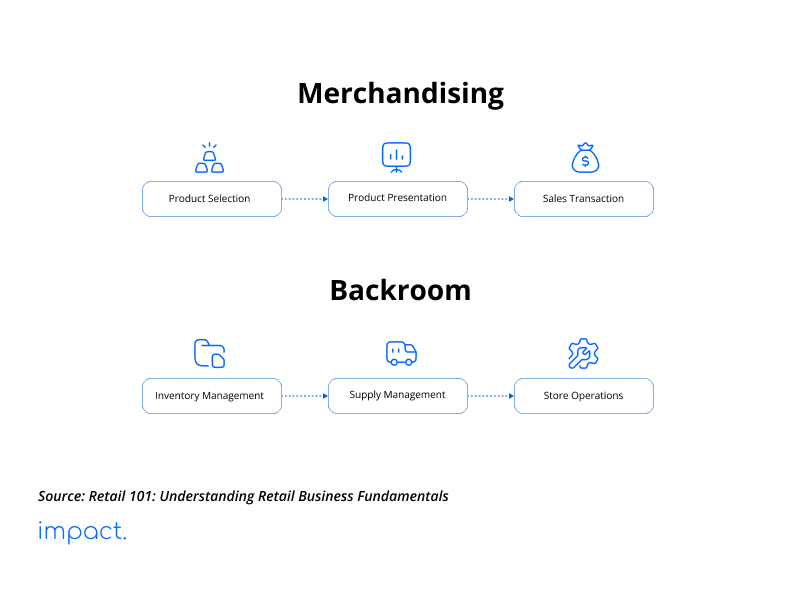Kanban: Definition, 6 Rules, and its Benefits
Kanban is a crucial part of the Just in Time (JIT) system, which we discussed…
Sean Thobias
May 17, 2025Dan Ramsey’s book “The Everything Guide to Starting and Running a Retail Store” defines retail as selling small quantities of products directly to customers. It comes from the French term “retailler,” meaning the literal division of goods.
This article is the introductory chapter for a broader comprehensive guide for anyone interested in the retail industry. This chapter covers the essential retail principles, different retail types, and opportunities and challenges for aspiring entrepreneurs.
Retailing consists of two main components that ensure the business runs smoothly:

Grocery stores and supermarkets offer a variety of food products, including fresh and packaged foods, as well as essential household items.
Pros:
Cons:
Convenience stores are small, open 24/7, and conveniently located for quick trips. They usually have simple foods, drinks, and everyday items; some are connected to gas stations.
Pros:
Cons:
Specialty stores focus on a specific product type, like different brands or styles in a particular category. You can usually find these stores on local main streets or in malls, and they aim to offer a unique and diverse range within their specialized niche.
Pros:
Cons:
A department store, usually found in malls, offers a wide variety of things like clothes and electronics all in one place. They’re known for having fancy brands, even though the prices are slightly higher.
Pros:
Cons:
An outlet store sells discounted products, often from a particular brand or maker. These stores offer lower prices because they have extra stock, end-of-season items, factory seconds, discontinued products, or items with minor defects.
Pros:
Cons:
Warehouse stores provide a wide range of products at prices lower than the market average. They’re famous for cost-effective options on essentials, and buying in bulk helps customers save more.
Pros:
Cons:
The key opportunity in retail today lies not in the product itself but in enhancing the sales process through retail technology. Implement modern point-of-sale (POS) systems at checkout for automated and efficient transactions, improving the overall customer experience.
Retailers can boost efficiency and cut costs by using advanced inventory management software. Products often have a Universal Product Code (UPC) to simplify inventory management.
More than 2.14 billion people shop online, a big jump from a few years ago. This statistic accounts for 27% of the world’s 7.9 billion population, showing a significant presence of digital buyers globally.
Retailers should make it simple for customers to connect with their brand in-store and online. To encourage repeat business, they should create loyalty programs that work smoothly regardless of whether customers shop online or in a physical store.
Data is helpful to stay ahead of competitors and offer customers products they like. Using data helps make targeted marketing campaigns, which are promotions designed for specific groups of customers, making them more relevant and likely to grab attention.
Most customers, around 71%, expect personalization when they shop. According to McKinsey, businesses that do well in personalization can boost their revenue by 10% to 15%.
E-commerce has changed how regular stores work. Online shops are popular because they are convenient, reasonably priced, and offer various products.
Traditional stores must invest heavily and adjust to new technology like POS systems, inventory tools, and online selling platforms to keep up. If not, then they will be further left behind by their competitors.
The Covid-19 pandemic created global supply chain issues, impacting retail operations. In 2021, 98% of retail executives experienced problems, with 59% anticipating higher prices or shipping costs for consumers.
Disruptions like shortages, delays, and higher costs have impacted retailers. Retailers must have a strong and flexible supply chain to tackle these challenges.
Rising operational costs, driven by higher minimum wages and increased real estate expenses, pose challenges for retailers. Small and independent retailers struggle to balance these costs while keeping prices competitive.
Starting a retail business comes with challenges and opportunities. Small retailers often face difficulties, as outlined by Dan Ramsey in his list of primary reasons for failure:
However, these reasons shouldn’t deter you from starting your retail store. Our guides will ensure you have the knowledge, information, market understanding, a good location, a solid plan, and enough funding to succeed.
In the next chapter, we will look at the planning stage of your retail business, which includes analyzing your assets, looking at franchises as an alternative, and writing your business plan.
Ramsey, D., & Ramsey, J. (2010). The Everything Guide to starting and running a retail store: All you need to get started and succeed in your own retail adventure. Adams Media.
Impact Insight Team
Impact Insights Team is a group of professionals comprising individuals with expertise and experience in various aspects of business. Together, we are committed to providing in-depth insights and valuable understanding on a variety of business-related topics & industry trends to help companies achieve their goals.
See how our ERP provides better value.
Speak with our consultant to explore how we can improve your accounting, processes, and people.
